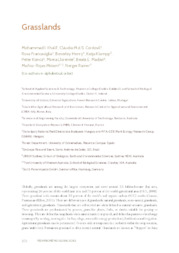Grasslands.
Grasslands.
Author(s): KHALIL, M. I.; CORDOVIL, C. M. D. S.; FRANCAVIGLIA, R.; HENRY, B.; KLUMPP, K.; KONCZ, P.; LLORENTE, M.; MADARI, B. E.; MUÑOZ-ROJAS, M.; RAINER, N.
Summary: Grasslands are among the largest ecosystems and cover around 3.5 billion-hectare (ha) area, representing 26 percent of the world land area and 70 percent of the world agricultural area. These grassland soils contain about 20 percent of the world?s soil organic carbon (SOC) stocks. There are different types of grasslands: natural grasslands, semi-natural grasslands, and agricultural grasslands. Grasslands that are self-seeded are often defined as natural or native grasslands. These grasslands are predominated by grasses, grass-like plants, forbs, or shrubs suitable for grazing or browsing. They are defined as rangelands when natural (native) or grazed, and defined as pastures when forage is managed by seeding, mowing (i.e. for hay, silage, renewable energy production), fertilization and irrigation. Agricultural grasslands can be permanent (>5-years old) or temporary (i.e. included within the crop rotation, grass/arable-ley). Permanent grassland is often (semi-) natural.
Publication year: 2021
Types of publication: Book sections
Unit: Embrapa Rice & Beans
Keywords: Carbon sequestration, Carbono, Grassland soils, Solo
Observation
Some of Embrapa's publications are published as ePub files. To read them, use or download one of the following free software options to your computer or mobile device. Android: Google Play Books; IOS: iBooks; Windows and Linux: Calibre.
Access other publications
Access the Agricultural Research Database (BDPA) to consult Embrapa's full library collection and records.
Visit Embrapa Bookstore to purchase books and other publications sold by Embrapa.

